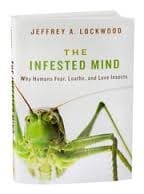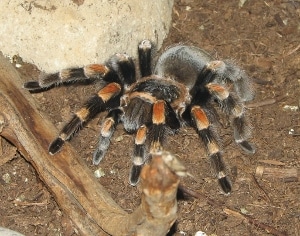Don’t let the bed bugs bite…
Author: Jeffrey A. Lockwood
 The reaction is so ingrained in the human psyche that the question seems ludicrous. Why does the sudden discovery that a spider is crawling on your shoulder so reliably elicit a shriek, followed immediately by flailing, screaming and jumping up and down? Even a small house spider, undoubtedly presenting absolutely no threat to a large human being, will provoke this response in 99.999% of the population worldwide. As everyone knows, the reason we’re scared of spiders is because they’re…..spiders. It’s both obvious and self-evident. Or maybe it’s not quite that simple. In The Infested Mind, entomologist Jeffrey Lockwood explores why so many people find so many bugs – and other assorted vermin – so consistently terrifying.
The reaction is so ingrained in the human psyche that the question seems ludicrous. Why does the sudden discovery that a spider is crawling on your shoulder so reliably elicit a shriek, followed immediately by flailing, screaming and jumping up and down? Even a small house spider, undoubtedly presenting absolutely no threat to a large human being, will provoke this response in 99.999% of the population worldwide. As everyone knows, the reason we’re scared of spiders is because they’re…..spiders. It’s both obvious and self-evident. Or maybe it’s not quite that simple. In The Infested Mind, entomologist Jeffrey Lockwood explores why so many people find so many bugs – and other assorted vermin – so consistently terrifying.
A grasshopper specialist at the University of Wyoming, Lockwood starts his quest for understanding with a personal story of panic and terror while engulfed in a massive swarm of grasshoppers on hot July day in Whalen Canyon a couple of hours from Laramie. Unable to fully recover from this traumatic experience, his career was forever transformed, prompting the rational scientist in him to try and decipher the mysteries. Why do we fear insects, spiders and the like? Is it the extra legs? The quick, skittering movements? The beady, lifeless eyes? Are we born with this natural inclination or do our parents teach us to fear all things creepy and crawly?
Delving into much of the psychology of phobias, the author proceeds on a wide ranging tour of humanity’s insect aversion, often alluding to entomophobe Salvador Dali’s frequent use of insects as symbols of terror and death. While avoidance of the filth and disease so often associated with insects might be evolutionarily beneficial, it seems like our fears go way beyond the logical. Lockwood presents numerous theories, but acknowledges that much remains to be understood about the ubiquity of maladies like arachnophobia and mottephobia (fear of moths).
The book is at its best when the author dissects the intricacies of disgust, a human emotion closely related to fear. What is it about the maggots in a dead crow or the cockroaches skittering across the kitchen counter that we find so repellant? Even just reading the preceding sentence might be enough to generate a smidgen of repugnance. Fully engrained in our mental makeup, all five senses can effectively elicit feelings of disgust and insects are particularly adept at triggering it. Until reading this book, I never realized how interesting disgust research could be.
Lockwood also discusses the opposite extreme, often known as biophilia, or the natural interest humans seem to have in other living things. Presenting arguments both for and against this theory of innate ecological wisdom, Lockwood goes a long way toward finding a harmonious balance between our innate phobias and the ecological benevolence we need to foster as a species.
When it comes to science books, scientists who write well have the advantage over journalists because they are experts, frequently offering special insights that add much to the overall reading experience. But sometimes scientists, who rarely write as well as journalists, squander their advantage by writing about a topic far removed from their area of expertise. This book is a perfect example of this dilemma. When an entomologist writes about human psychology, the obstacles are considerable. Lockwood does a reasonable job, although he’s not a good enough writer or psychologist to call this an unqualified success. While he does a nice job of incorporating his own personal story into the book, his heavy reliance on outside sources and quotes grows tiresome at times.
More about psychology than entomology, The Infested Mind is an interesting look at the interface between the human mind and all the creepy little, multi-legged beasts out there that give us fits. Whether they populate our homes or our nightmares, everybody probably has a bug – or several – that triggers a particularly strong sense of revulsion, leaving logic and rationality far behind. While this centipedophobe didn’t like the book as much he hoped he would, he can still award it four out of five stars and recommend it to anyone who likes to read about insects and their brethren.
— D. Driftless
Other Readers Lane reviews of books that daringly combine nature and fear:
The Book of Deadly Animals / Spillover / The Devils Teeth / Swimming with Piranhas at Feeding Time
- Best Non-Fiction of 2016 - February 1, 2017
- Little Free Library Series — Savannah - May 22, 2015
- Little Free Library Series — Wyoming - November 30, 2014




Leave A Comment